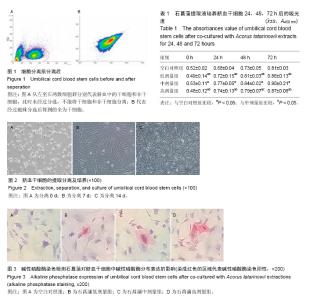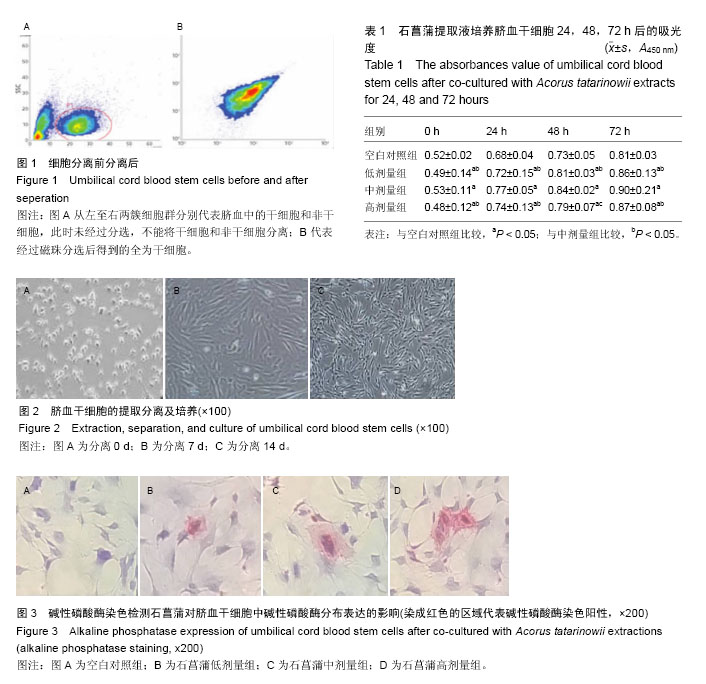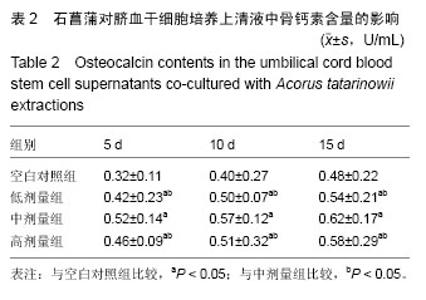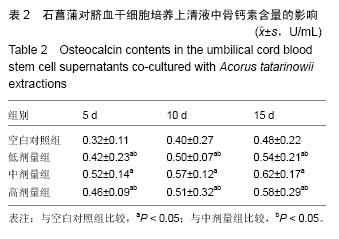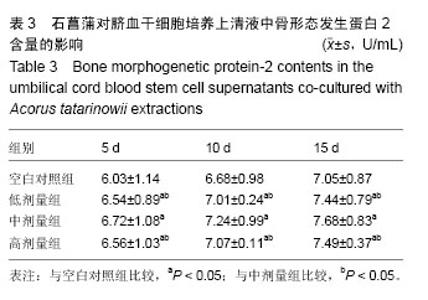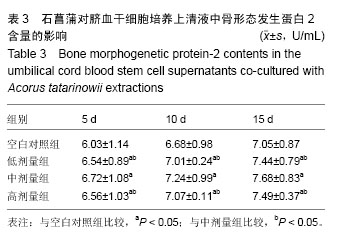| [1] Cui X, Chen L, Xue T et al.Human umbilical cord and dental pulp-derived mesenchymal stem cells: biological characteristics and potential roles in vitro and in vivo.Mol Med Rep.2015;11(5):3269-3278.
[2] Mueller AA, Forraz N, Gueven S et al.Osteoblastic differentiation of Wharton jelly biopsy specimens and their mesenchymal stromal cells after serum-free culture.Plast Reconstr Surg.2014;134(1):59e-69e.
[3] Liang ZH,Cheng XH,Ruan ZG,et al.Protective effects of components of the Chinese herb grassleaf sweetflag rhizome on PC12 cells incubated with amyloid-beta42. Neural Regen Res. 2015;10(8): 1292-1297.
[4] Lynch K,Pei M.Age associated communication between cells and matrix: a potential impact on stem cell-based tissue regeneration strategies. Organogenesis.2014;10(3):289-298.
[5] Xu M,Zhang B,Liu Y,et al.The immunologic and hematopoietic profiles of mesenchymal stem cells derived from different sections ofhuman umbilical cord.Acta Biochim Biophys Sin (Shanghai). 2014; 46(12):1056-1065.
[6] Ha CZ,Chen HY, Wang J,et al.Effect of diabetic osteoblasts on osteogenic differentiation of human umbilical cord mesenchymal stem cells.Biomed Pap Med Fac Univ Palacky Olomouc Czech Repub.2015; 159(3):388-393.
[7] Doan CC, Le TL, Hoang NS, et al.Differentiation of umbilical cord lining membrane-derived mesenchymal stem cells into endothelial-like cells.Iran Biomed J. 2014;18(2):67-75.
[8] Fakhry M, Hamade E, Badran B,et al.Molecular mechanisms of mesenchymal stem cell differentiation towards osteoblasts.World J Stem Cells.2013;5(4): 136-148.
[9] Lee JH, Hah YS, Cho HY, et al. Human umbilical cord blood-derived CD34-positive endothelial progenitor cells stimulate osteoblasticdifferentiation of cultured human periosteal-derived osteoblasts.Tissue Eng Part A.2014;20(5-6):940-953.
[10] Chen E, Tang MK, Yao Y,et al.Silencing BRE expression in human umbilical cord perivascular (HUCPV) progenitor cells accelerates osteogenic and chondrogenic differentiation. PLoS One.2013;8(7): e67896.
[11] Stanko P, Kaiserova K, Altanerova V,et al.Comparison of human mesenchymal stem cells derived from dental pulp, bone marrow, adipose tissue, andumbilical cord tissue by gene expression.Biomed Pap Med Fac Univ Palacky Olomouc Czech Repub. 2014;158(3):373-377.
[12] Liu S, Hou KD, Yuan M,et al. Characteristics of mesenchymal stem cells derived from Wharton's jelly of human umbilical cord and for fabrication of non-scaffold tissue-engineered cartilage.J Biosci Bioeng.2014;117(2):229-235.
[13] Pan H, Lan J, Luo X,et al.Biologic properties of gadolinium diethylenetriaminepentaacetic acid-labeled and PKH26-labeled humanumbilical cord mesenchymal stromal cells.Cytotherapy. 2014;16(1): 74-83.
[14] Hong SH, Maghen L, Kenigsberg S,et al.Ontogeny of human umbilical cord perivascular cells: molecular and fate potential changes during gestation.Stem Cells Dev. 2013;22(17):2425-2439.
[15] Marupanthorn K, Tantrawatpan C, Tantikanlayaporn D,et al.The Effects of TNF-α on Osteogenic Differentiation of Umbilical Cord Derived Mesenchymal Stem Cells.J Med Assoc Thai.2015;98 Suppl 3:S34-40.
[16] Qu J, Lu D, Guo H et al.MicroRNA-9 regulates osteoblast differentiation and angiogenesis via the AMPK signaling pathway.Mol Cell Biochem. 2016;411 (1-2):23-33.
[17] Luthringer BJ, Willumeit-Römer R.Effects of magnesium degradation products on mesenchymal stem cell fate and osteoblastogenesis. Gene. 2016; 575(1):9-20.
[18] Li T,Zhang C,Ding Y,et al.Umbilical cord-derived mesenchymal stem cells promote proliferation and migration in MCF-7 and MDA-MB-231 breast cancer cells through activation of the ERK pathway.Oncol Rep.2015;34(3):1469-1477.
[19] Satué M, Ramis JM, Monjo M. UV-activated 7-dehydrocholesterol-coated titanium implants promote differentiation of human umbilical cordmesenchymal stem cells into osteoblasts. J Biomater Appl.2016;30(6):770-779.
[20] Huang L, Niu C, Willard B,et al. Proteomic analysis of porcine mesenchymal stem cells derived from bone marrow and umbilical cord: implication of the proteins involved in the higher migration capability of bone marrow mesenchymal stem cells. Stem Cell Res Ther. 2015;6:77.
[21] Shimazu T, Mori Y,Takahashi A,et al.Serum- and xeno-free cryopreservation of human umbilical cord tissue as mesenchymal stromal cell source. Cytotherapy.2015;17(5):593-600.
[22] Zhang L, Liu D, Pu D et al. The role of Toll-like receptor 3 and 4 in regulating the function of mesenchymal stem cells isolated from umbilical cord.Int J Mol Med. 2015;35(4):1003-1010.
[23] Cui X, Chen L, Xue T et al. Human umbilical cord and dental pulp-derived mesenchymal stem cells: biological characteristics and potential roles in vitro and in vivo. Mol Med Rep.2015;11(5):3269-3278.
[24] Buyl K, Vanhaecke T, Desmae T,et al. Evaluation of a new standardized enzymatic isolation protocol for human umbilical cord-derived stem cells.Toxicol In Vitro.2015;29(6):1254-1262.
[25] Lynch K, Pei M.Age associated communication between cells and matrix: a potential impact on stem cell-based tissue regeneration strategies. Organogenesis.2014;10(3):289-298.
[26] Xu M,Zhang B,Liu Y,et al.The immunologic and hematopoietic profiles of mesenchymal stem cells derived from different sections of human umbilical cord. Acta Biochim Biophys Sin (Shanghai).2014;46(12): 1056-1065.
[27] Xiao YZ, Wang S.Differentiation of Schwann like cells from human umbilical cord blood mesenchymal stem cells in vitro. Mol Med Rep.2015;11(2):1146-1152.
[28] Chao YH, Wu HP, Wu KH,et al.An increase in CD3+CD4+CD25+ regulatory T cells after administration of umbilical cord-derived mesenchymal stem cells during sepsis. PLoS One.2014;9(10): e110338.
[29] Xu Z,Sheng L,Ouyang G.Umbilical cord blood-derived mesenchymal stem cells inhibit proliferation of peripheral blood lymphocytes. Xi Bao Yu Fen Zi Mian Yi Xue Za Zhi.2014;30(9):968-971.
[30] Shekels LL, Colvin Wanshura LE, Xie Y,et al. The effects of Gremlin1 on human umbilical cord blood hematopoietic progenitors.Blood Cells Mol Dis.2015; 54(1):103-109.
[31] Gao Y,Liu F,Zhang L,et al. Acellular blood vessels combined human hair follicle mesenchymal stem cells for engineering of functional arterial grafts. Ann Biomed Eng.2014;42(10):2177-2189.
[32] Li D,Chai J,Shen C,et al.Human umbilical cord-derived mesenchymal stem cells differentiate into epidermal-like cells using a novel co-culture technique. Cytotechnology.2014;66(4):699-708. |
